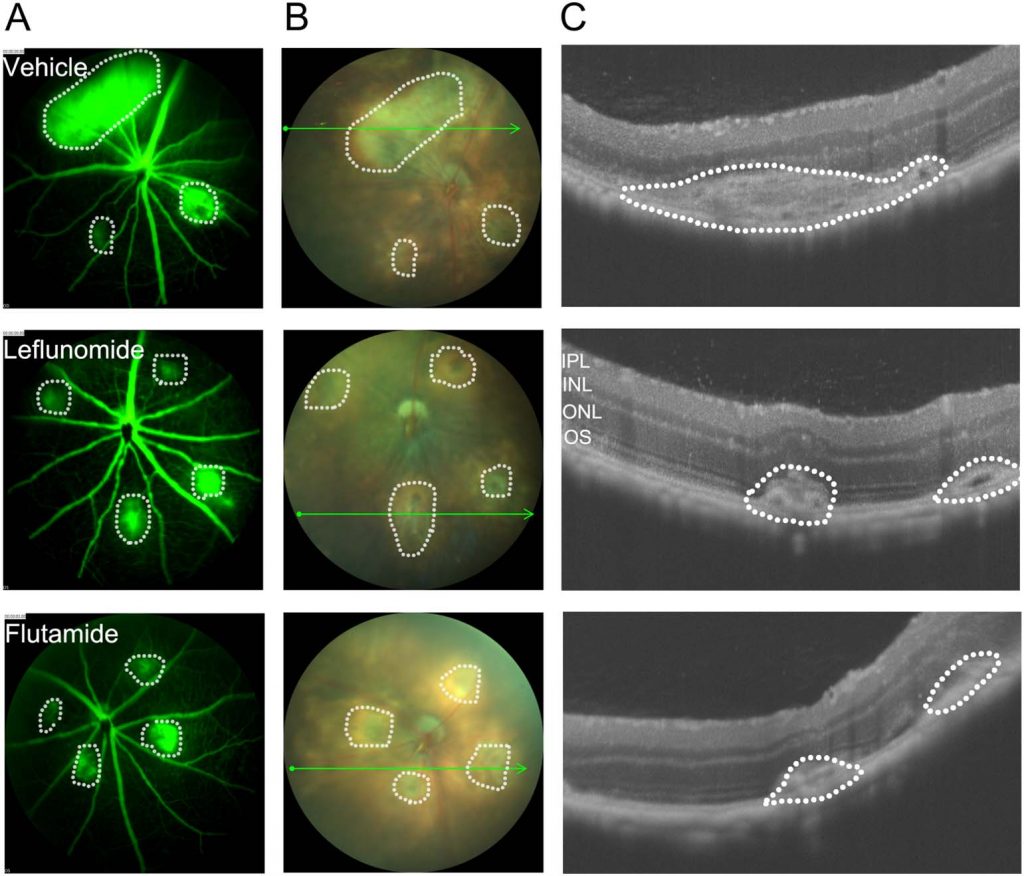Age-related macular degeneration affects tens of millions of people worldwide, leading to vision impairment and blindness. Anti-VEGF treatment helps only 25-40% of patients, leaving others with no recourse to this progressive blinding disease. In their article, “Suppression of aberrant choroidal neovascularization through activation of the aryl hydrocarbon receptor,” Choudhary et al explore potential treatment using two compounds that activate the aryl hydrocarbon receptor. They use the Phoenix MICRON® IV rodent fundus camera and OCT to show that the compounds significantly improve choroidal neovascularization lesions in mice.
The aryl hydrocarbon receptor is a transcription factor with many roles related to cell homeostasis. Dysfunction is linked with development of retinal diseases including age-related macular degeneration. Choudhary et al screened many aryl hydrocarbon receptor activating compounds, selected two for further study, leflunomide and flutamide, and created choroidal neovascularization in aged mice by delivering laser power that pierced Bruch’s membrane. The laser piercing Bruch’s membrane causes new blood vessels growth in the choroid which is a standard rodent model of age-related macular degeneration. Though Phoenix offers an easy-to-use image-guided laser to create lesions using the Phoenix MICRON® IV system, Choudhary et al used a slit-lamp laser.
The mice received daily intraperitoneal injection of one of the compounds or vehicle starting two days before the laser application and for nineteen days afterwards. Choudhary et al then examined the mice fundus and fluorescein angiography with the Phoenix MICRON® IV system and the retinal layers using the Phoenix MICRON® IV image-guided OCT (Fig 1). Fluorescein angiography shows leakage of the lesions which is proportional to lesion size (fig 1A); the filters for fluorescein angiography are included in the Phoenix MICRON® IV basic model. Mice treated with either compound showed a decrease in lesion size and leakage in both the fundus and OCT images. The Phoenix MICRON® IV OCT revealed clearly defined boundaries of hyper-reflective regions with displacement of the retinal layers overlying the lesion (Fig 1C). While many studies examine the choroidal neovascularization lesions at seven to fourteen days, Choudhary et al waited for nineteen days to look at mature lesions with some fibrosis. The compounds improved the laser-induced lesions but did not affect the integrity of the retinal pigment epithelium or choroid in non-lasered areas.
Choudhary et al present a thorough study from screening compounds, examining in-vitro effects, to showing compelling evidence of disease improvement in mice that indicates that aryl hydrocarbon receptor pathways regulates pathogenesis of choroidal neovascularization lesion formation and may be an excellent target for treatment of age-related macular degeneration.
Choudhary, M., Safe, S., & Malek, G. (2018). Suppression of aberrant choroidal neovascularization through activation of the aryl hydrocarbon receptor. Biochimica Et Biophysica Acta. Molecular Basis of Disease, 1864(5 Pt A), 1583–1595.
